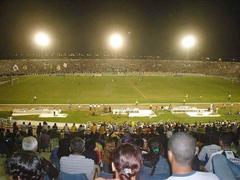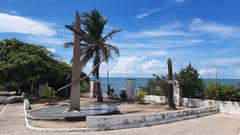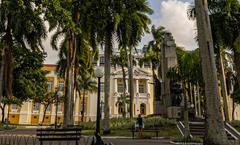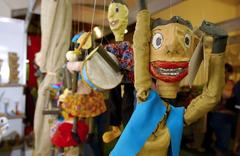
Joao Pessoa Historic Center: Visiting Hours, Tickets, and Attractions Guide
Date: 04/07/2025
Introduction
The Historic Center of João Pessoa, capital of Paraíba state in Brazil, stands as one of the country’s most remarkable urban heritage districts. Established in 1585 as Cidade Real de Nossa Senhora das Neves, the area is a living chronicle of Brazil’s colonial past, architectural diversity, and vibrant community traditions. Visitors are enchanted by its harmonious blend of Baroque and colonial landmarks—like the São Francisco Cultural Center, the largest Baroque monument in Latin America—and bustling artisan markets, colorful squares, and cultural festivals. Whether you’re a history enthusiast, architecture lover, or curious traveler, this guide offers up-to-date information on visiting hours, ticketing, accessibility, and insider tips to help you plan an immersive journey through João Pessoa’s unique heritage (wildtrips.net; e-a-a.com; tempoutil.com).
Table of Contents
- Colonial Foundations and Early Development
- Architectural Heritage and Styles
- Cultural Significance and Community Life
- Visitor Information: Hours, Tickets, and Accessibility
- Preservation and Restoration Efforts
- The Historic Center in Contemporary João Pessoa
- Must-See Landmarks
- Visitor Tips and Practical Information
- Events and Cultural Life
- Frequently Asked Questions (FAQ)
- Conclusion and Call to Action
- Reliable Sources and Further Reading
Colonial Foundations and Early Development
Founded on August 5, 1585, João Pessoa’s Historic Center is among Brazil’s oldest continuously inhabited urban cores. Its origins as a Portuguese colonial stronghold attracted both ambition and conflict: throughout the 16th and 17th centuries, the area witnessed battles between Portuguese, Dutch, and French forces vying for control over the region (wildtrips.net). The city’s original grid layout features narrow, winding streets radiating from central plazas, with stone churches, convents, and administrative buildings constructed using local materials and European techniques—reflecting a fusion of imported and indigenous craftsmanship (e-a-a.com).
Architectural Heritage and Styles
Baroque and Colonial Landmarks
The Historic Center’s architectural highlights are predominantly colonial and Baroque in style. The São Francisco Cultural Center (Centro Cultural São Francisco) stands as a crowning achievement—an architectural complex begun in 1589 and completed over nearly two centuries, interrupted by wars and changing regimes. This site includes the Church of São Francisco and the Convent of Santo Antônio, renowned for gilded altars, intricate woodcarvings, azulejo tilework, and serene cloisters (e-a-a.com; thetouristchecklist.com).
Other notable colonial-era landmarks include:
- Basilica Nossa Senhora das Neves: Founded in 1586, reconstructed in the 17th century, blending stuccoed exteriors, red-tile roofs, and Baroque altars.
- Church and Monastery of São Bento: Featuring Renaissance and Baroque motifs, a grand altar, and active monastic life (wanderlog.com).
- Church of Our Lady of Mercy: A simple yet historically significant structure known for its role in colonial social services (trek.zone).
Eclectic and Modernist Influences
The early 20th century brought eclectic styles, such as the Loja Maçônica Branca Dias (1918), combining neoclassical, art nouveau, and Masonic symbolism. Modernist touches also appear in public spaces and civic buildings, coexisting with older structures to create a visually diverse cityscape (e-a-a.com).
Cultural Significance and Community Life
The Historic Center serves as João Pessoa’s social, religious, and cultural nucleus. Churches and convents historically functioned as community centers for education, charity, and worship. Today, restored venues like the São Francisco Cultural Center host exhibitions, concerts, and festivals (tempoutil.com). Public squares such as Praça Antenor Navarro and Parque Solon de Lucena (“Lagoa”) remain lively hubs for events, markets, and gatherings.
Local artisans keep traditions alive through handicrafts, ceramics, and textiles, sold in colorful markets and shops. Community workshops and performances reinforce the area’s living heritage (tempoutil.com).
Visitor Information: Hours, Tickets, and Accessibility
Visiting Hours
- Most sites: Tuesday to Sunday, 9:00 AM – 5:00 PM
- Cathedral Basilica: Daily, 7:00 AM – 7:00 PM
- Casa da Pólvora: Wednesday to Sunday, 10:00 AM – 4:00 PM
Always confirm hours for individual sites, especially during holidays (oncototravel.com.br).
Tickets and Tours
- Entry fees: R$2–R$15 for most attractions; many churches free.
- Discounts: Children under 7 and seniors over 65 often enter free or at reduced rates.
- Tickets: Purchase onsite or book online for popular sites.
- Guided tours: Local operators offer insightful walking tours in Portuguese, sometimes English or Spanish. Advance booking recommended (thetouristchecklist.com).
Accessibility
While the district’s colonial layout can pose challenges, key sites have ramps or assistance. Public squares are generally accessible, but cobblestone streets may require care for visitors with mobility concerns.
Preservation and Restoration Efforts
João Pessoa’s commitment to heritage preservation includes structural restorations, authentic design replication, and sustainable materials (e-a-a.com). Community engagement is central, with residents participating in workshops and volunteer projects. Despite urban pressures, the Historic Center is one of Brazil’s best-preserved colonial districts, drawing scholars and heritage tourists alike.
The Historic Center in Contemporary João Pessoa
The area is a major tourist draw, with historic buildings now housing museums, galleries, restaurants, and boutique hotels (wildtrips.net). Annual festivals—including Festa das Neves—celebrate local traditions and reinforce the district’s role as João Pessoa’s cultural heart (brazilcityguides.com). Modern usage blends seamlessly with heritage conservation, ensuring enduring relevance (tempoutil.com).
Must-See Landmarks
- São Francisco Cultural Center: Baroque complex with church, convent, and museum (e-a-a.com)
- Basilica Nossa Senhora das Neves: Historic church with colonial and baroque elements.
- Loja Maçônica Branca Dias: Early 20th-century eclectic building.
- Parque Solon de Lucena (Lagoa): Central park and leisure hub.
- Praça Antenor Navarro: Square bordered by colonial houses and cultural venues.
- Casa da Pólvora: 18th-century fortification and cultural space.
These sites narrate the story of João Pessoa’s transformation from colonial outpost to a city cherishing its heritage (wildtrips.net; tempoutil.com).
Visitor Tips and Practical Information
Getting There
- Centrally located, accessible by car, taxi, Uber, or public bus.
- Limited parking—walking is best for exploring the compact district (Ecoturismo e Cultura).
Budgeting
- Entrance fees are low (R$2–R$15).
- Many sites accept credit cards, but carry cash for markets.
Safety
- The area is safe during the day; avoid deserted streets after dark.
- Use trusted transportation and keep valuables secure (STR Specialist; sacavoyage.fr).
Food and Shopping
- Enjoy regional Brazilian cuisine in established restaurants.
- Artisan markets offer crafts, textiles, and souvenirs (thetouristchecklist.com).
Accessibility
- Some buildings have steps and uneven floors; check accessibility in advance.
- Wear comfortable shoes for walking on cobblestones.
Events and Cultural Life
Annual Highlights
- Festas Juninas (June): Colorful street festivals, music, and food.
- Samba de Caboclo (July): Afro-Brazilian cultural celebrations.
- Viva Usina (April–October): Contemporary arts and performances (blog.blablacar.com.br).
- Carnival and Holy Week: Religious processions and festive parades.
- Nightly Musical Performances: Sunset concerts at Casa da Pólvora and riverfront.
Daily Life
- Public squares, cafés, and bars like Hotel Globo are popular social spots.
- Regular markets and artisan fairs foster a lively community atmosphere (wildtrips.net).
Frequently Asked Questions (FAQ)
Q: What are the visiting hours for most historic sites?
A: Generally Tuesday to Sunday, 9:00 AM – 5:00 PM. Some churches open daily; always confirm for special dates.
Q: How much do tickets cost?
A: Most sites charge R$2–R$15; many churches are free.
Q: Can I book tickets online?
A: Some attractions offer online ticketing; otherwise, buy onsite.
Q: Are guided tours available?
A: Yes, in Portuguese and sometimes English or Spanish. Booking ahead is recommended.
Q: Is the Historic Center accessible for people with disabilities?
A: Key sites are partially accessible, but cobblestones and steps may pose challenges.
Q: What’s the best time to visit?
A: Mornings or late afternoons for cooler temperatures and ideal lighting. June and July feature major festivals.
Q: Is the area safe?
A: Yes, during the day. Be vigilant at night and avoid isolated areas.
Conclusion and Call to Action
The Historic Center of João Pessoa is a treasure trove of colonial history, cultural vibrancy, and living community traditions. With affordable tickets, flexible visiting hours, and a calendar full of cultural events, it offers visitors an immersive window into Brazil’s architectural and social heritage. To enrich your experience, download the Audiala app for guided audio tours and up-to-date event notifications, and follow official tourism platforms for the latest updates on festivals and new attractions.
Reliable Sources and Further Reading
- Exploring João Pessoa Historic Center: Visiting Hours, Tickets, and Must-See Historical Sites, 2025, Wild Trips (wildtrips.net)
- 10 Best Architectural Buildings in João Pessoa, 2025, E-A-A (e-a-a.com)
- João Pessoa Tourism Guide, 2025, Tempo Util (tempoutil.com)
- Architectural Highlights and Must-See Sites in João Pessoa Historic Center: Visiting Hours, Tickets, and Insider Tips, 2025, The Tourist Checklist (thetouristchecklist.com)
- Historic Center of João Pessoa: Visiting Hours, Tickets, and Top Attractions in João Pessoa, 2025, Oncoto Travel (oncototravel.com.br)
- Cultural Tourism in Paraíba and João Pessoa, 2025, Ecoturismo e Cultura (ecoturismoecultura.com)
- Historic Center of João Pessoa: Visiting Hours, Cultural Events, and Local Life Guide, 2025, BlaBlaCar Blog (blog.blablacar.com.br)
- Ultimate Travel Tips for João Pessoa, 2025, STR Specialist (strspecialist.com)




